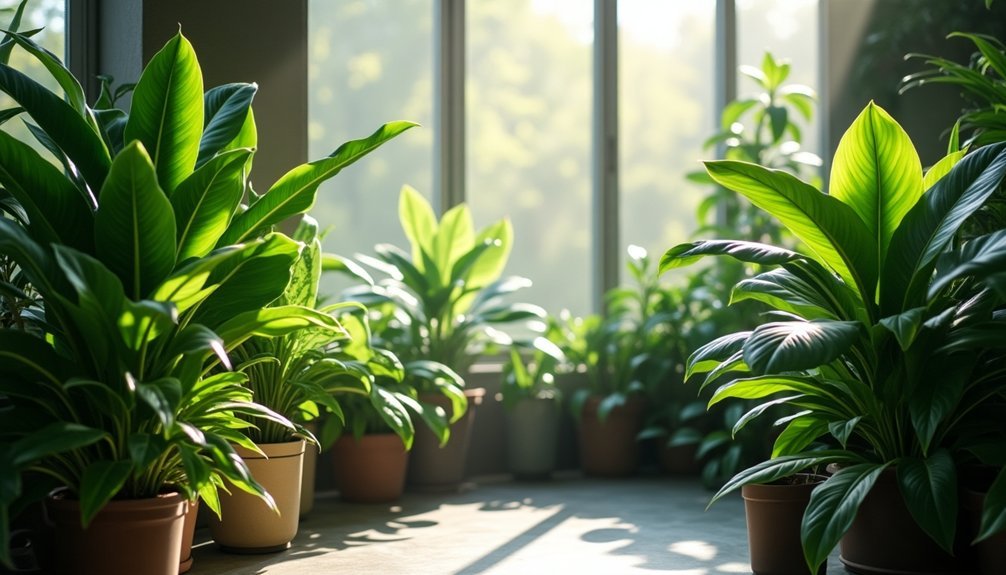Looking to naturally purify your indoor air? You'll find powerful allies in the Peace Lily, Spider Plant, and Snake Plant. These proven air-filtering champions effectively remove common toxins like formaldehyde, benzene, and carbon dioxide from your home. Place them in bright, indirect light and keep their soil moist for peak performance. Understanding how to position and care for these living air filters can transform your indoor air quality.
Types of Indoor Plants Known for Toxic Air Filtration

Nature's silent guardians, indoor air-filtering plants serve as living air purification systems in our homes and offices.
You'll find several powerful options to improve air quality and combat volatile organic compounds in your living spaces.
The Peace Lily and Spider Plant excel at removing formaldehyde and benzene, while the Boston Fern tackles xylene and toluene while boosting humidity.
If you're looking to eliminate formaldehyde and increase moisture levels, the Bamboo Palm's your best choice.
For bedroom air purification, consider the Snake Plant, which uniquely converts CO2 to oxygen during nighttime hours.
To maximize your indoor air quality benefits, you'll want to incorporate a variety of these natural filtration champions throughout your space.
Each brings specific strengths to your air purification strategy, working together to create a healthier environment.
Optimal Placement and Care for Air-Purifying Plants
Once you've selected your air-purifying plants, their placement and care will determine their effectiveness as natural filtration systems. You'll want to position them in areas with bright, indirect light to maximize their ability to absorb toxins from your indoor air.
| Care Aspect | Best Practice | Benefits |
|---|---|---|
| Light | Bright, indirect | Enhanced growth and filtration |
| Watering | Keep soil moist | Maintains plant health |
| Maintenance | Dust leaves regularly | Improves absorption |
Group your plants together to create a microenvironment with higher humidity levels, which helps them work more efficiently. Don't forget to keep their leaves clean – regular dusting guarantees they can effectively absorb pollutants. Place your plants in high-traffic areas of your home where they'll have the most impact on air quality.
Scientific Research Behind Plant-Based Air Detoxification

Scientific evidence continues to validate the remarkable ability of houseplants to purify indoor air. NASA's groundbreaking Clean Air Study revealed that certain plants can reduce volatile organic compounds by up to 60%, transforming our understanding of indoor air quality.
Through phytoremediation, plants naturally absorb and break down harmful air pollutants like formaldehyde and benzene.
You'll find the science particularly fascinating when it comes to microbial communities. These tiny organisms, living in plant root systems, work synergistically with their host plants to enhance air detoxification.
Environmental science research has demonstrated that strategic placement of specific houseplants creates a sustainable solution for cleaner air.
When you're choosing plants for your space, remember that this isn't just about aesthetics – you're implementing a scientifically proven method of natural air purification.
Frequently Asked Questions
Do Air Filters Remove Toxins?
Yes, air filters can remove toxins from your air. HEPA filters capture tiny particles, while activated carbon absorbs VOCs and other harmful compounds. You'll get the best results using filters that combine these technologies.
Do Air Purifiers Get Rid of Toxic Fumes?
Yes, your air purifier can eliminate toxic fumes when equipped with activated carbon filters. You'll get the best results by using units with both HEPA and carbon filters, plus maintaining them regularly.
What Air Purifier Does NASA Recommend?
You'll want a HEPA filter-based purifier with activated carbon, as NASA recommends. For best results, look for units that combine UV light and photocatalytic oxidation technology to effectively eliminate particles and gases.
Which Air Purifier Destroys Formaldehyde?
You'll find the Alen BreatheSmart 75i, IQAir Atem X, and AirDoctor 5500i effectively destroy formaldehyde with their activated carbon filters. For best results, make sure you maintain regular filter replacements.
In Summary
You'll breathe easier knowing these natural air purifiers are working around the clock in your home. Place these plants strategically in high-traffic areas and maintain them properly to maximize their air-cleaning potential. While they won't completely replace your air purifier, they're an eco-friendly addition to your indoor air quality plan. Keep researching new plant varieties as scientists continue discovering more about their detoxifying abilities.





Leave a Reply